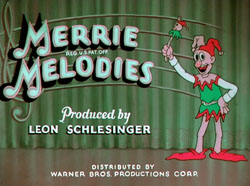 Most of the Merrie Melodies from the 1935-36 season were in heavy rotation on local television and cable television whenever the AAP Merrie Melodies package was distributed. This was true despite the fact that most of the cartoons had lost their topicality, and might have seemed like just another song and a dance to the kids at which they were aimed. Most of these were still running on Los Angeles television as late as the mid-1980’s – both in English and dubbed into Spanish. Those of us with long memories can recall seeing tem on locally-hosted kids’ shows wherever we lived. The AAP package, with its run of Bugs Bunny cartoons, was enormously successful wherever it ran, and included most of the cartoons featured in this post. Even one that became part of the “Censored 11″ may have been included in television runs at the onset of AAP’s distribution.
Most of the Merrie Melodies from the 1935-36 season were in heavy rotation on local television and cable television whenever the AAP Merrie Melodies package was distributed. This was true despite the fact that most of the cartoons had lost their topicality, and might have seemed like just another song and a dance to the kids at which they were aimed. Most of these were still running on Los Angeles television as late as the mid-1980’s – both in English and dubbed into Spanish. Those of us with long memories can recall seeing tem on locally-hosted kids’ shows wherever we lived. The AAP package, with its run of Bugs Bunny cartoons, was enormously successful wherever it ran, and included most of the cartoons featured in this post. Even one that became part of the “Censored 11″ may have been included in television runs at the onset of AAP’s distribution.
The Lady In Red (9/7/35) – Plot: music and frolic among the Mexican cockroaches at a night club/café. Songs include the title song, introduced by Wini Shaw and demolished by Judy Canova in the feature film, In Caliente, recorded widely. Victor gave it to the artist they figured most appropriate to the tune, as a Rumba: Xavier Cugat. Brunswick gave it to Louis Prima and his New Orleans Gang, while Melotone and the other dime-store labels gave it to Joe Haymes and his band. The song was also recorded by some Country artists. Decca had a version by Pappy Zeke Ezra and Elton (featuring the yodeling singer Elton Britt). Melotone and the dime-stores had a country version by the Prairie Ramblers, who were featured on the “National Barn Dance” over WLS in Chicago and on the Blue Network for NBC.
Also featured in the cartoon soundtrack: “Sweet Music” by Warren and Dubin, from the Rudy Vallee Warner Bros. movie of the same name; and “South American Joe”, a number more popular in England than in this country, recorded by Ambrose on Decca (also issued here in the U.S.), and by Harry Roy on Parlophone. Also featured: “Neapolitan Nights”, a song written by J. S. Zamecnic and later used for the 1928 feature Fazil. It was recorded in 1925 by Don Clark and his LaMonica Ballroom Orchestra for Victor, and in 1928 by Nat Shilkret and the Victor Orchestra on the same label.
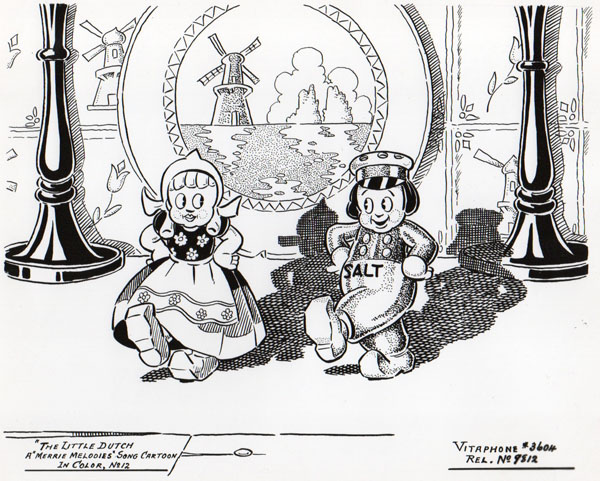
Little Dutch Plate (10/19/35) – Plot: a melodrama involving characters in the cupboards of a kitchen featuring decorative Dutch plates. Songs: You’ll hear a German-flavored number, “Puppchen”, which was recorded for Brunswick by Freddy Martin and his Orchestra, and on Melotone and the dime-store labels by Johnny Johnson and his Orchestra. As for the title tune, “The Girl on the Little Dutch Plate”, it’s apparently an original – the music is by Louis Alter, the lyrics are by Jack Scholl – which never made it to commercial records. It was first heard in a Vitaphone 2-color Technicolor short called Springtime in Holland (1935). Here’s a clip:

Billboard Frolics (11/9/35) – Plot: an alley cat chases the “chicken who hasn’t scratched yet” from “My Ami Cleanser” (a takeoff on “Bon Ami” Cleanser). Song featured: “Merrily We Roll Along”, by Eddie Cantor and Murray Mencher. There are no known contemporaneous commercial recordings of this song, but there is an aircheck of Eddie performing same on one of his Pebeco radio shows.
The tune was finally recorded in 1960 for Little Golden Records (also featured on the 1961 album release “Bugs Bunny Songfest”), with lyrics altered to spotlight all the Looney Tunes characters with which it had become associated. I believe that’s Gilbert Mack doing the all the character voices. Greg Ehrbar further discusses this album here.
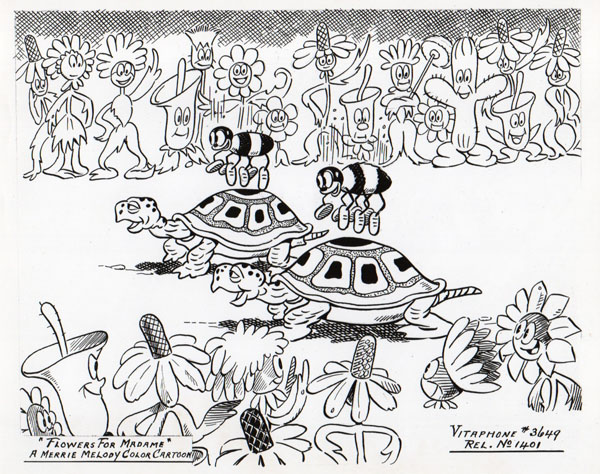
Flowers For Madame (11/20/35) – Warner’s answer to “Flowers and Trees”, including a pageant of floats put on by various flowers, and the inevitable bout with a fire outburst. Title song was recorded on Victor by Ray Noble’s American orchestra (organized vby Glenn Miller). Noble’s band played it on one of the Coty radio broadcasts as well. The dime stores gave it to a band credited as Bob Causer and his Cornellians, which was actually a Russ Morgan studio band with vocal by Chick Bullock. Decca also covered it, giving it to a brand new band: Bob Crosby (Bing’s glorious-voiced “kid” brother). Bob does not sing on the recording, vocal being taken by Frank Tenille. Aside from the title song, we have “Oh, You Beautiful Doll” (also the subject of a Max Fleischer screen song), and”The Campbells are Coming”, the go-to fugue for anything Scottish, like thistles and heather.
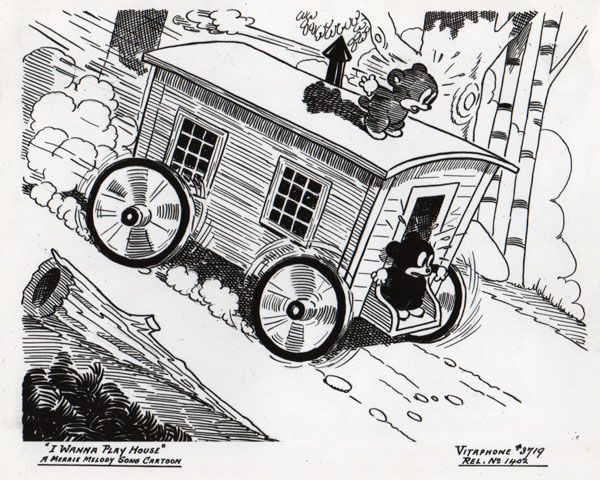
I Wanna Play House (1/11/36) – Plot: two little bears cavort in a gypsy wagon, then wind up sending it out of control. Notable songs: “I’m Singing Because I’m Gay” (please note: “gay” is used in the traditional dictionary definition!) – no commercial recordings known.
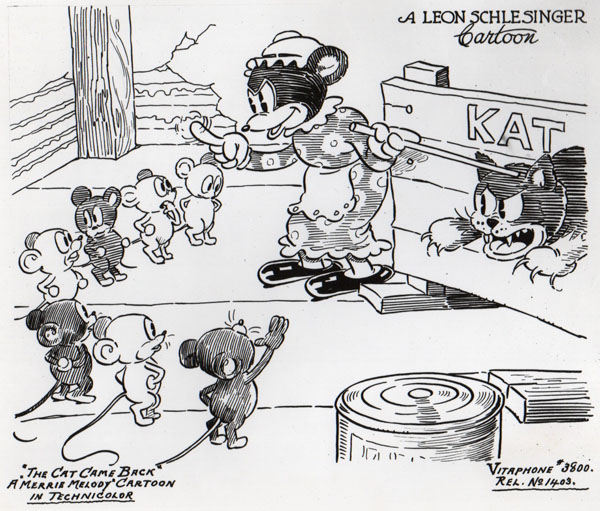
The Cat Came Back (2/8/36) – Mama Cat is truying to teach her kittens how to chase mice, while Mama Mouse is teaching her children how to avoid the cats. Eventually, one of the young mice saves one of the kittens from being swept away, and Mama Cat and Mama Mouse become friends out of the crisis – at least for a few moments. The title song is very nearly the only one featured – I know of no commercial recordings.
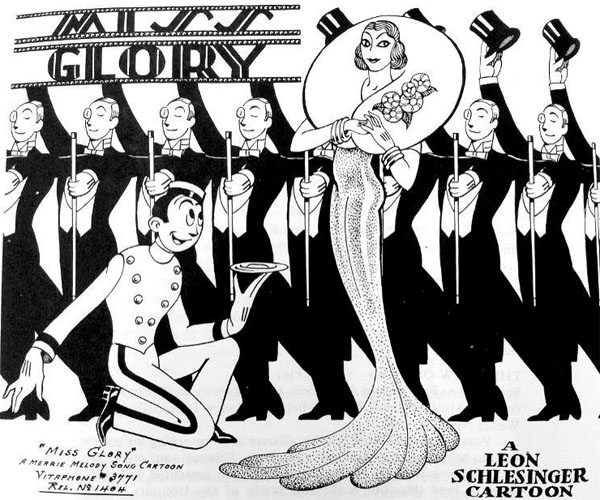
Miss Glory (3/7/36) – Plot: Abner, bellhop of the Hicksville Hotel, is anticipating the arrival of a celebrity, Miss Glory. Abner falls asleep and dreams that the Hicksville Hotel is transforned into the Cosmopolitan Hotel (the kind of swank place he imagines Miss Glory normally frequents). This is an exercise in “art moderne” as provided by Leodora Congdon, according to the credits (although supervision was actually performed anonymously by Fred “Tex” Avery). After harried efforts in his dream to page the diva (whom he envisions as a stunning beauty), he awakens to page the real Miss Glory – who is a six year old moppet, voiced by Bernice Hansen, who states “Boy, do I slay’em”, then commands the theater orchestra, “Play Don” (a catch-phrase from Jack Benny’s radio show of 1935-36, for which Don Bestor provided the music).
Songs: “Page Miss Glory”, introduced in the film of the same name and recorded commercially by Dick Piowell for Brunswick, and also recorded by the dance band of Paul Pendarvis for Columbia. Also included: “Wal, I Swan”; and “Lullaby of Broadway”, introduced by Wini Shaw in “Gold Diggers of 1935″, done as a vocal record for Shaw on Decca, and in dance performances by Richard Himber on Victor, Hal Kemp on Bunswick, and Johnny Johnson on Melotone et al.
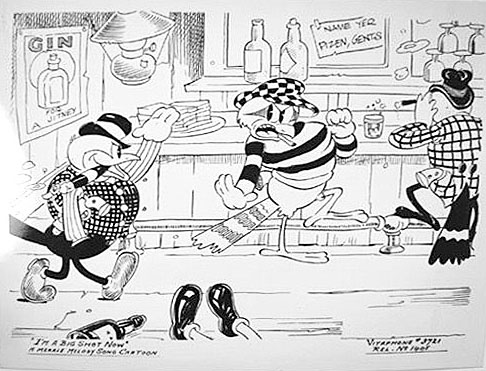
I’m a Big Shot Now (4/11/36) – Plot: life in Birdville, concentrating on a tough hard-boilled yegg who sings the title song, robs a bank, and gets apprehended by the local constabilary, causing him to change lyrics and sing, “I’m just a jail bird now.” Title song to the best of my knowledge was never commercially recorded – but was first featured in the Sybil Jason movie Little Big Shot (1935). Also heard: “Sweet and Slow”, which did get recordings by Fats Waller for Victor, and a few years later by Ginny Simms for Vocalion.
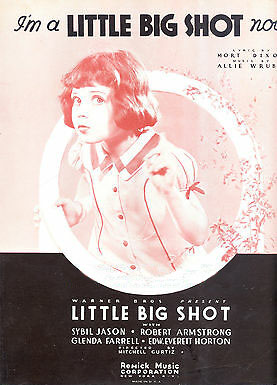
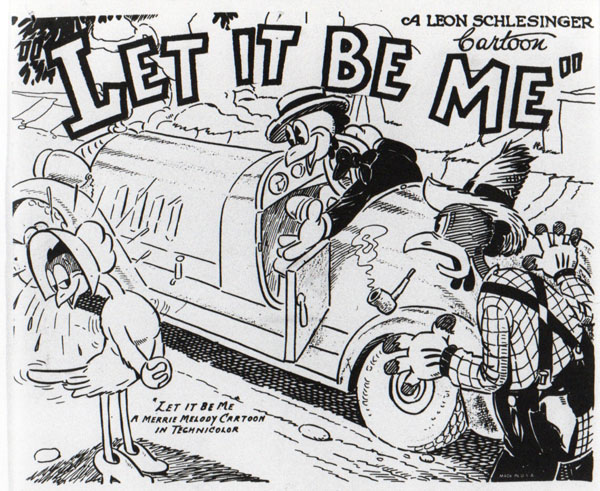
Let It Be Me (5/2/36) – All the hens are crazy for crooning Mr. Bingo, including country hen Emily, who gets lured into a trip to the city by the crooner. She gets thrown over, and winds up selling violets in the snow, when her boyfriend Elmer comes to the city to throttle Mr. Bingo. Later, when one of their kids starts to practice “Boo Boo Boo Boo”, the parents throw a book at him. The title song, from the feature Broadway Hostess, was introduced in the musical by Phil Regan, who recorded it for Columbia. It was cut for Decca by Joe Sanders out of Chicago.
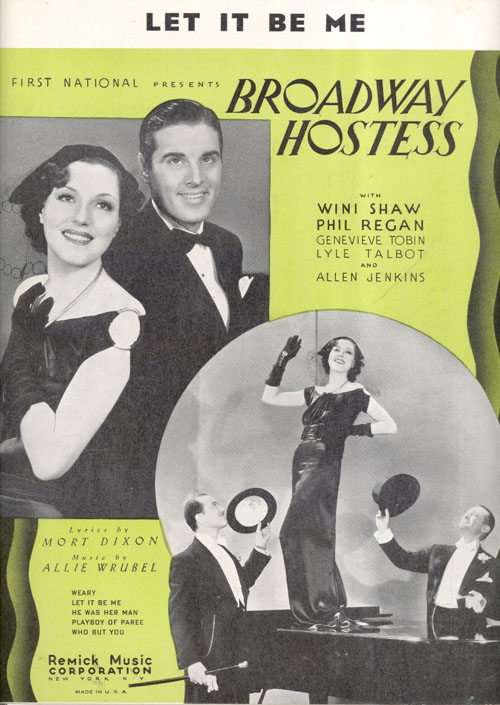
They reached into the reliquary for “I’ve Got My Eye On You”, a 1930 song introduced in a Warner musical and recorded by a “Ted Wallace” group on Harmony, Velvet Tone, Diva, and Clarion, four low priced labels offered by Columbia for sale in various dime stores.
Also included in the cartoon was “I Wanna Woo”, which we’ll meet again in other Warner cartoons in subsequent articles. “Woo” was recrded by Leo Reisman and his Orchestra for Brunswick, with vocal by Sally Singer (real name Sally Schermerhorn!) and also recorded for the dime stores by Joe Haymes and his Orchestra (a sort of hard-luck band leader, who would no sooner assemble a band than have his precious bundle stolen away from him by another band leader).
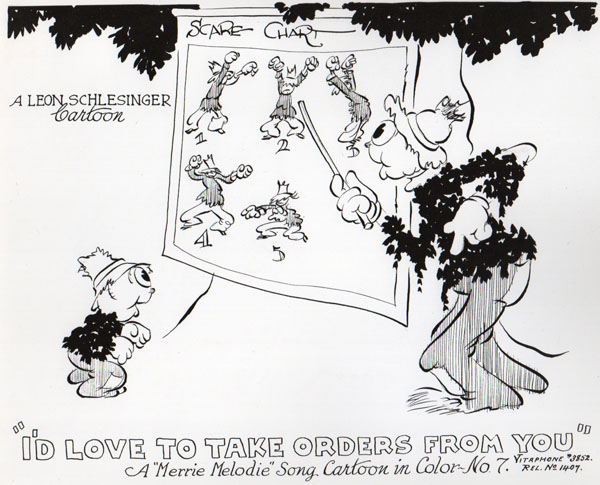
I’d Love To Take Orders From You (5/18/36) – Plot: Junior scarecrow wants to be like daddy, and practices frightening poses, but fails to scare a single crow. Title song, from the feature Shipmates Forever, yet another Dick Powell musical, was recorded widely. Richard Himber did it with his smooth society band for Victor. Brunswick and Columbia both issued a version credited to Jacques Renard and his Orchestra (presumably a Russ Morgan studio group) with vocal by Chick Bullock. Decca gave the song to a personality bandleader, Phil Harris (known to modern-day fans as Baloo the Bear and several other Disney roles). Vocalion gave it to Mildred Bailey with an all-star jazz combo behind her. The old standard favorite, “Home Sweet Home” is also used as a cue.
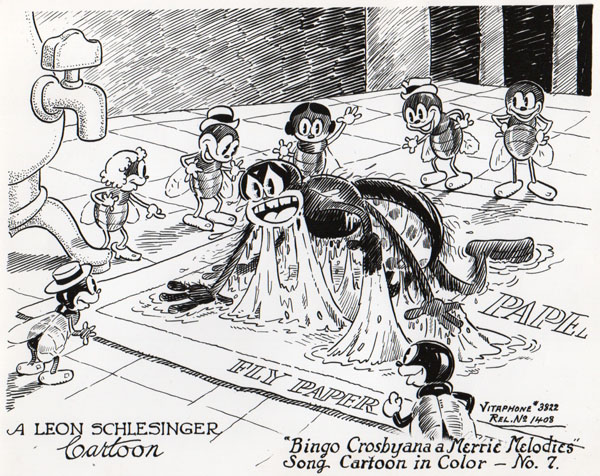
Bingo Crosbyana (5/30/36) – Bingo Crosbyana, the crooning kid of all Havana, proves to be not so brave when it comes to battling a spider, Songs: There is a title song of which no commercial recordings are known. The lyric refers to “A great big Stutz” that is something “Mama Don’t Want.” Interesting referemnce, in that the Stutz Motor Co. stopped producing cars in 1935. Also included: “La Golondrina”, a traditional Spanish language song. Here’s that – by Xavier Cugat:
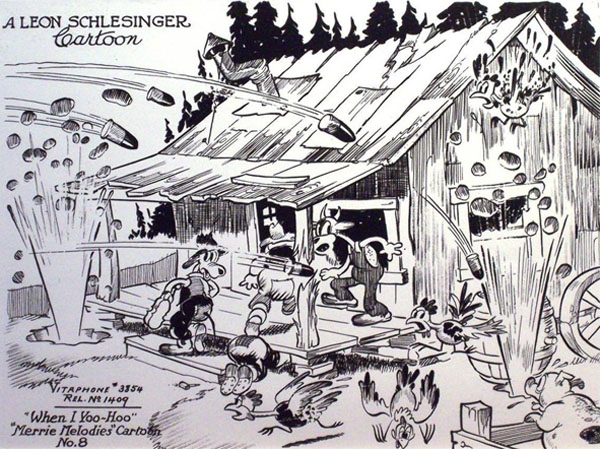
When I Yoo Hoo (7/1/36) – A feud between two families out in hillbilly country is to be settled by a rooster fight at Higgins’ Barn – loser will leave the county. Song: “When I Yoo-Hoo In The Valley”, written by Henry Russell and Murray Martin, was apparently only recorded in 1939 by country crooners Lulu Belle and Scotty.
I Love To Singa (7/18/36) – Professor Fritz Owl and wife are expecting a new flock – but one of them turns out to be “a crooner – a jazz singer!” Fritz teaches voice – piano – violin- but NO JAZZ. The kid gets thrown out of the house, but runs off to perform on Jack Bunny’s Amateur Show (this may be the first Warner cartoon to take off on the persona of Jack Benny). The kid sees his folks through the window, and reverts to singing their kind of music. He is about to get the gong, but Fritz darts in and tells him to be himself. Songs: Of course, the title song is well featured, which was introduced by Al Jolson and “Cab” Calloway in “The Singing Kid”, Jolson’s last starring feature for Warner Brothers. “Cab” Calloway did record the song for Brunswick. Jimmy Dorsey got it for Decca. Victor and Bluebird appear to have ignored the songs from this picture entirely. Also featured: the main tenor portion from the Sextet of “Lucia Di Lammermoor”; “Drink To Me Only With Thine Eyes”, an old parlor favorite; and Mendelssohn’s Spring Song.
Sunday Go To Meetin’ Time (8/11/36) – Nicodemus would rather be shiftless and lazy and shoot craps rather than go to church, but a nightmare turns him toward the strait and narrow path. Songs: The title song (an original – no commercial recordings), “Shout All Over God’s Heaven”, a traditional spiritual, and “You’ve Got To Give the Devil His Due”, another original with no commercial recordings.

At Your Service, Madame (8/29/36) – W.C. Squeals (portrayed as a pig with a suction cup nose) hears of the fortune Mrs. Hamhock has received, and decides to call upon her to see if he can avail himself of some of that loot. However, Mrs. H’s piglets, especially the miscievous Piggy, can see right through him and what he’s interested in. They upset his attempts to court Mrs. H., and she eventually realizes what’s really on his mind.
Songs: the title song is given a ride by W.C. Squeals as a courting song to Mrs. H. – Not widely recorded: only Decca seems to have tried to give it a push. They released a version by Bob Crosby and his Orchestra, while their short-lived Champion marque had a version credited to “Ted Russell and his Orchestra” (actually the Riley/Farley Orchestra from the Onyx Club on 52nd street in Manhattan, which enjoyed great success with the original version of “The Music Goes Round and Round”). Here’s the track from the 1935 WB feature Stars Over Broadway, featuring Jane Froman:
Next time: Looney Tunes 1936-37: Well, we’ve got one star. Let’s try for another!


 James Parten has overcome a congenital visual disability to be acknowledged as an expert on the early history of recorded sound. He has a Broadcasting Certificate (Radio Option) from Los Angeles Valley College, class of 1999. He has also been a fan of animated cartoons since childhood.
James Parten has overcome a congenital visual disability to be acknowledged as an expert on the early history of recorded sound. He has a Broadcasting Certificate (Radio Option) from Los Angeles Valley College, class of 1999. He has also been a fan of animated cartoons since childhood.












































Again, what a great selection of songs! I’m a little embarrassed that my favourite is the one with all the yodeling. Well, no, that’s not true. I’m not embarrassed at all.
I don’t know which is funnier, Judy Canova’s performance of “The Lady in Red” or Edward Everett Horton’s hilarious reactions to it. (A quarter century later, of course, Horton would narrate Jay Ward’s “Fractured Fairy Tales”.) Carl Stalling would get a lot of mileage out of that song, for example in “The Windblown Hare” (1949), in which Bugs Bunny dons Little Red Riding Hood’s cloak and sings “The Rabbit in Red” while skipping to Grandma’s house.
Interesting that Charles Farrell would play an exotic, romantic sheikh role in “Fazil”. I remember him best as Gale Storm’s father in the sitcom “My Little Margie”, but he also played the romantic lead in “Moonlight Sonata” (1937), featuring pianist/composer/former Polish Prime Minister Ignaz Jan Paderewski in his old age.
“Puppchen! Du bist mein Augenstern! Puppchen! Hab’ dich zum Fressen gern!” Too bad you didn’t include a recording of that song, which I remember well; my grandfather used to sing it when I was little. “Puppchen” was a 1912 operetta by Jean Gilbert (Max Winterfeld), and its title song was a huge hit. (It can be translated as “Dolly”, and may also be applied to an attractive petite woman.) Unfortunately Gilbert/Winterfeld was forced to leave Germany when the Nazis took power, and he spent his last years leading a radio orchestra in Buenos Aires, where he died in 1942. Mercifully, he never learned that “Puppchen” was the nickname given to a German anti-tank rocket launcher developed late in the war.
Did anyone else notice that the first phrase of the melody in “I Wanna Woo” is identical to that of “Singin’ in the Rain”?
Looking forward to rolling along with your next post — merrily, of course!
Yes, I noticed the similarity between those two songs, Paul!
RE: James Parten – On I’d Love To Take Orders From You, “Dear Little Boy of Mine” by prolific songwriter Egbert Van Alstyne (“Drifting and Dreaming”, “What’s the Matter with Father”..) is the “weepy” tune heard near the end – the first of many times it would be used by Stalling.
“When I Yoo-Hoo in the Valley” is a really engaging song, true; you can tell the singers are enjoying themselves, and I love the fiddle playing backing them up. I might try to play this for some local bluegrass bands, and see if any of them would be interested in reviving it.
I seem to recall reading that Stalling would later use “The Lady in Red” a lot usually when one of directors would use a red pencil to plot out a cartoon.
Simply wonderful!!
I love to singa is one of my all-time favorites!
I’m loving this series.🌝
.
I love Louis Prima’s version of The Lady In Red. He shows his Armstrong roots with his singing and strong trumpet playing while clarinetist Pee Wee Russell is just incredible. Real hot performance! https://www.youtube.com/watch?v=R4QcQX6QP50
Splendid work James, and the epitome of Cartoon Research to be sure. Thank you for your endless excavation of film, music and animation history.
These films (with Humans!!) are truly fascinating, thank YOU!!! (I swear to you, i never knew “Page Miss Glory” was another entity besides the toon!!)
Thanks for giving Joe Haymes a shout out. He led, I believe, five different bands during the ’30s before going back to his first love, arranging. He left us 250 very fine recordings.